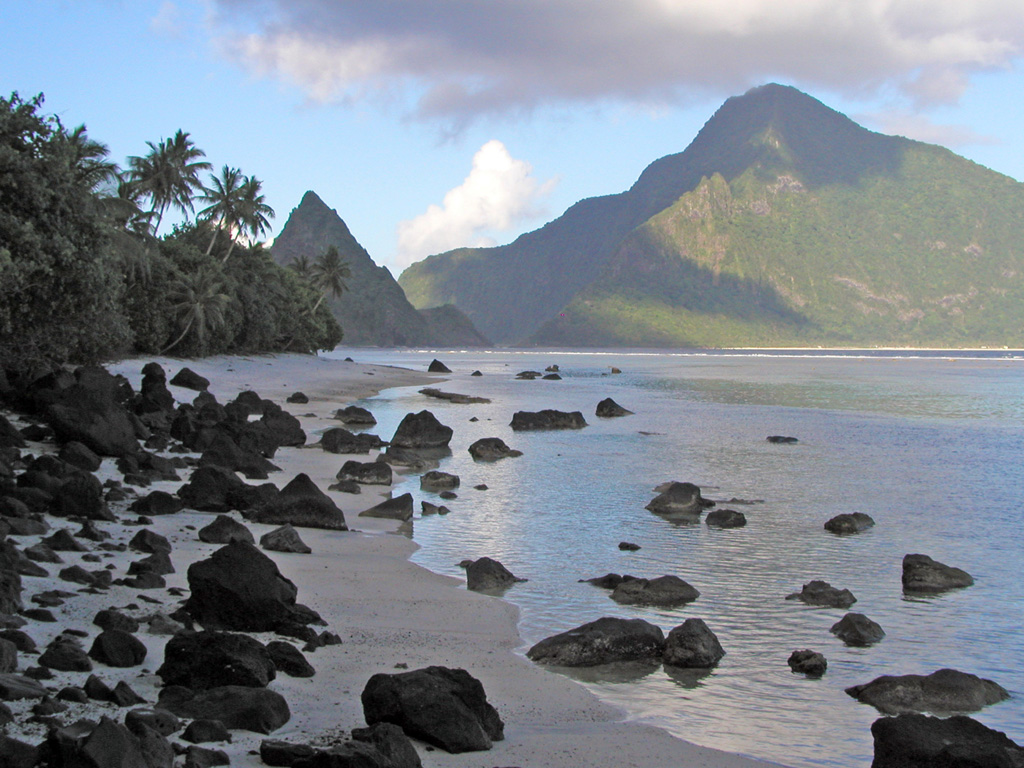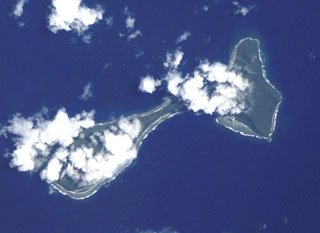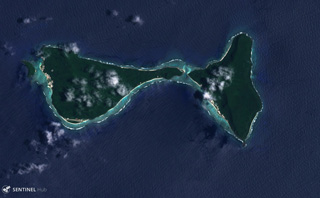

Data from seismometers recently installed on Tutuila, Ta’u, and Ofu-Olosega islands of American Samoa to monitor an ongoing seismic swarm indicated that the events were related to Ta’u Island and not Ofu-Olosega. HVO lowered the Volcano Alert Level to Normal and the Aviation Color Code to Green on 26 August. The report warned residents of Ofu-Olosega that they could still be significantly affected by events that may take place on or around Ta’u Island.
Source: US Geological Survey Hawaiian Volcano Observatory (HVO)
2022: August
Data from seismometers recently installed on Tutuila, Ta’u, and Ofu-Olosega islands of American Samoa to monitor an ongoing seismic swarm indicated that the events were related to Ta’u Island and not Ofu-Olosega. HVO lowered the Volcano Alert Level to Normal and the Aviation Color Code to Green on 26 August. The report warned residents of Ofu-Olosega that they could still be significantly affected by events that may take place on or around Ta’u Island.
Source: US Geological Survey Hawaiian Volcano Observatory (HVO)
HVO reported that an earthquake swarm in the Manu’a Islands of American Samoa continued to be recorded and felt by residents of Ta’u Island and Ofu-Olosega. About 20 earthquakes per hour were recorded by four microseismometers distributed on Tutuila, Ta’u, and Ofu-Olosega Islands. The largest events were estimated to be between magnitudes 2 and 3; most events are too small to be felt. Analysis of the seismic data indicated that the earthquakes were occurring beneath or around the Manu’a Islands, likely closer to Ta’u rather than Ofu-Olosega, though the exact locations, depths, and magnitudes were unknown. The number, size, and frequency of earthquakes recorded by instruments and being felt by people and on both islands indicated that seismicity was above background levels; HVO changed the Volcano Alert Level to Advisory and the Aviation Color Code to Yellow for both volcanoes. Earthquakes continued to be recorded at around the same rate during 20-22 August. Two additional seismometers were installed on Ta’u during 22-23 August.
Source: US Geological Survey Hawaiian Volcano Observatory (HVO)
The Global Volcanism Program has no Bulletin Reports available for Ofu-Olosega.
|
|
||||||||||||||||||||||||||
There is data available for 1 confirmed eruptive period.
1866 Sep 12 - 1866 Nov 15 ± 5 days Confirmed Eruption (Explosive / Effusive) VEI: 2
| Episode 1 | Eruption (Explosive / Effusive) | Submarine vent 3 km SE of Olosega | ||||||||||||||||||
|---|---|---|---|---|---|---|---|---|---|---|---|---|---|---|---|---|---|---|---|
| 1866 Sep 12 - 1866 Nov 15 ± 5 days | Evidence from Observations: Reported | ||||||||||||||||||
|
List of 2 Events for Episode 1 at Submarine vent 3 km SE of Olosega
|
|||||||||||||||||||
This compilation of synonyms and subsidiary features may not be comprehensive. Features are organized into four major categories: Cones, Craters, Domes, and Thermal Features. Synonyms of features appear indented below the primary name. In some cases additional feature type, elevation, or location details are provided.
Cones |
||||
| Feature Name | Feature Type | Elevation | Latitude | Longitude |
| A'ofa | Shield volcano | 494 m | 14° 10' 30.00" S | 169° 39' 47.00" W |
| Fatuaga Point | Cone | 230 m | 14° 10' 7.00" S | 169° 38' 18.00" W |
| Maga Point | Cone | 23 m | 14° 11' 32.00" S | 169° 36' 45.00" W |
| Nu'u | Tuff cone | 76 m | 14° 10' 4.00" S | 169° 41' 5.00" W |
| Sili | Shield volcano | |||
| Tauga Point | Tuff cone | 249 m | 14° 9' 48.00" S | 169° 40' 21.00" W |
| To'aga | Cone | |||
 Clouds drape the tops of the two islands of Ofu (left) and Olosega (right) in eastern Samoa in this International Space Station image (N is to the top left). The islands, 6 km in combined length, are separated by a narrow strait. They are formed by two eroded, coalescing basaltic shield volcanoes truncated by mostly-submarine calderas. A submarine eruption took place in 1866 about 3 km SE of Olosega, along the ridge connecting Olosega with Ta'u Island.
Clouds drape the tops of the two islands of Ofu (left) and Olosega (right) in eastern Samoa in this International Space Station image (N is to the top left). The islands, 6 km in combined length, are separated by a narrow strait. They are formed by two eroded, coalescing basaltic shield volcanoes truncated by mostly-submarine calderas. A submarine eruption took place in 1866 about 3 km SE of Olosega, along the ridge connecting Olosega with Ta'u Island.
 A narrow strait (just left of center) separates the two triangular islands of Ofu (left) and Olosega (right) in eastern Samoa. The islands are formed by two eroded, coalescing shield volcanoes. The narrow, steep-sided ridge forming the W side of Ofu Island is cut by volcanic dikes and an intrusive plug forms the sharp spire on Ofu Island to the left. A submarine eruption took place in 1866 at the far end of the two islands, 3 km SE of Olosega, along the ridge connecting Olosega with Ta'u Island.
A narrow strait (just left of center) separates the two triangular islands of Ofu (left) and Olosega (right) in eastern Samoa. The islands are formed by two eroded, coalescing shield volcanoes. The narrow, steep-sided ridge forming the W side of Ofu Island is cut by volcanic dikes and an intrusive plug forms the sharp spire on Ofu Island to the left. A submarine eruption took place in 1866 at the far end of the two islands, 3 km SE of Olosega, along the ridge connecting Olosega with Ta'u Island. Ofu (left) and Olosega (right) in eastern Samoa are parts of the same volcano separated by the Asaga Strait, with the island group reaching nearly 9 km across (including the smaller island to the west), shown in this 29 October 2018 Sentinel-2 satellite image (N is at the top). The islands have likely been shaped by flank failures with resulting debris avalanches below sea level.
Ofu (left) and Olosega (right) in eastern Samoa are parts of the same volcano separated by the Asaga Strait, with the island group reaching nearly 9 km across (including the smaller island to the west), shown in this 29 October 2018 Sentinel-2 satellite image (N is at the top). The islands have likely been shaped by flank failures with resulting debris avalanches below sea level.There are no samples for Ofu-Olosega in the Smithsonian's NMNH Department of Mineral Sciences Rock and Ore collection.
| Copernicus Browser | The Copernicus Browser replaced the Sentinel Hub Playground browser in 2023, to provide access to Earth observation archives from the Copernicus Data Space Ecosystem, the main distribution platform for data from the EU Copernicus missions. |
| MIROVA | Middle InfraRed Observation of Volcanic Activity (MIROVA) is a near real time volcanic hot-spot detection system based on the analysis of MODIS (Moderate Resolution Imaging Spectroradiometer) data. In particular, MIROVA uses the Middle InfraRed Radiation (MIR), measured over target volcanoes, in order to detect, locate and measure the heat radiation sourced from volcanic activity. |
| MODVOLC Thermal Alerts | Using infrared satellite Moderate Resolution Imaging Spectroradiometer (MODIS) data, scientists at the Hawai'i Institute of Geophysics and Planetology, University of Hawai'i, developed an automated system called MODVOLC to map thermal hot-spots in near real time. For each MODIS image, the algorithm automatically scans each 1 km pixel within it to check for high-temperature hot-spots. When one is found the date, time, location, and intensity are recorded. MODIS looks at every square km of the Earth every 48 hours, once during the day and once during the night, and the presence of two MODIS sensors in space allows at least four hot-spot observations every two days. Each day updated global maps are compiled to display the locations of all hot spots detected in the previous 24 hours. There is a drop-down list with volcano names which allow users to 'zoom-in' and examine the distribution of hot-spots at a variety of spatial scales. |
|
WOVOdat
Single Volcano View Temporal Evolution of Unrest Side by Side Volcanoes |
WOVOdat is a database of volcanic unrest; instrumentally and visually recorded changes in seismicity, ground deformation, gas emission, and other parameters from their normal baselines. It is sponsored by the World Organization of Volcano Observatories (WOVO) and presently hosted at the Earth Observatory of Singapore.
GVMID Data on Volcano Monitoring Infrastructure The Global Volcano Monitoring Infrastructure Database GVMID, is aimed at documenting and improving capabilities of volcano monitoring from the ground and space. GVMID should provide a snapshot and baseline view of the techniques and instrumentation that are in place at various volcanoes, which can be use by volcano observatories as reference to setup new monitoring system or improving networks at a specific volcano. These data will allow identification of what monitoring gaps exist, which can be then targeted by remote sensing infrastructure and future instrument deployments. |
| Volcanic Hazard Maps | The IAVCEI Commission on Volcanic Hazards and Risk has a Volcanic Hazard Maps database designed to serve as a resource for hazard mappers (or other interested parties) to explore how common issues in hazard map development have been addressed at different volcanoes, in different countries, for different hazards, and for different intended audiences. In addition to the comprehensive, searchable Volcanic Hazard Maps Database, this website contains information about diversity of volcanic hazard maps, illustrated using examples from the database. This site is for educational purposes related to volcanic hazard maps. Hazard maps found on this website should not be used for emergency purposes. For the most recent, official hazard map for a particular volcano, please seek out the proper institutional authorities on the matter. |
| IRIS seismic stations/networks | Incorporated Research Institutions for Seismology (IRIS) Data Services map showing the location of seismic stations from all available networks (permanent or temporary) within a radius of 0.18° (about 20 km at mid-latitudes) from the given location of Ofu-Olosega. Users can customize a variety of filters and options in the left panel. Note that if there are no stations are known the map will default to show the entire world with a "No data matched request" error notice. |
| UNAVCO GPS/GNSS stations | Geodetic Data Services map from UNAVCO showing the location of GPS/GNSS stations from all available networks (permanent or temporary) within a radius of 20 km from the given location of Ofu-Olosega. Users can customize the data search based on station or network names, location, and time window. Requires Adobe Flash Player. |
| DECADE Data | The DECADE portal, still in the developmental stage, serves as an example of the proposed interoperability between The Smithsonian Institution's Global Volcanism Program, the Mapping Gas Emissions (MaGa) Database, and the EarthChem Geochemical Portal. The Deep Earth Carbon Degassing (DECADE) initiative seeks to use new and established technologies to determine accurate global fluxes of volcanic CO2 to the atmosphere, but installing CO2 monitoring networks on 20 of the world's 150 most actively degassing volcanoes. The group uses related laboratory-based studies (direct gas sampling and analysis, melt inclusions) to provide new data for direct degassing of deep earth carbon to the atmosphere. |
| Large Eruptions of Ofu-Olosega | Information about large Quaternary eruptions (VEI >= 4) is cataloged in the Large Magnitude Explosive Volcanic Eruptions (LaMEVE) database of the Volcano Global Risk Identification and Analysis Project (VOGRIPA). |
| EarthChem | EarthChem develops and maintains databases, software, and services that support the preservation, discovery, access and analysis of geochemical data, and facilitate their integration with the broad array of other available earth science parameters. EarthChem is operated by a joint team of disciplinary scientists, data scientists, data managers and information technology developers who are part of the NSF-funded data facility Integrated Earth Data Applications (IEDA). IEDA is a collaborative effort of EarthChem and the Marine Geoscience Data System (MGDS). |